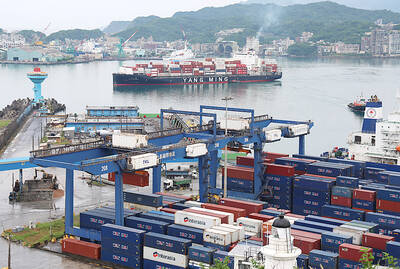Syrian beekeeper Ibrahim Damiriya is struggling to produce honey from his hives on parched land near the capital, Damascus, after years of war, economic collapse and worsening climate change effects.
“The war bled us dry. We could barely keep our beekeeping business afloat, and then the insane weather made things worse,” the 62-year-old said, wearing a beekeeping suit as he examined meager honey stocks inside the hives.
Before Syria’s conflict erupted in 2011, Damiriya owned 110 hives in Rankus, a village near Damascus that was once filled with apple orchards.

Photo: AFP
Now a combination of fighting, severe drought and a grueling economic crisis have left him with a mere 40 hives in semi-arid lands, devastating his honey yield.
Rankus was once renowned for its honey, but was hard hit by fighting between government forces and rebels that caused widespread destruction, pushing many residents to flee.
Damiriya can barely afford to tend to his hives, donated by the International Committee of the Red Cross (ICRC) to help Syrian beekeepers.
“If we keep suffering from climate change and rising prices, I might have to abandon my profession,” Damiriya said with a sigh.
Since 2011, Syria’s war has killed more than 500,000 people and caused an acute economic crisis, exacerbated by severe Western sanctions.
The past few years have also battered Syria with heat waves, low rainfall and more forest fires.
A 2019 UN report found that fighting had practically wiped out hives, with bombs contaminating the environment and pesticide misuse and a proliferation of parasites speeding up their decline.
Syria used to be home to 635,000 hives before the war, but their numbers had dwindled to about 150,000 at the height of the conflict in 2016, said Iyad Daaboul, the Damascus-based president of the Arab Beekeepers Union.
That number has risen back up to 400,000, he said.
However, the hives yield only 1,500 tonnes of honey per year — half of the country’s pre-war production.
Unusually cold springs and drought have had an adverse effect on the flowers that bees feed on.
“Extreme weather conditions have greatly affected bees, especially during spring — the most important time in their life cycle,” Daaboul said.
The number of beekeepers has nearly halved from 32,000 before the war to about 18,000 today, he said.
Another threat to the bees are the forest fires that have become more common as temperatures rise.
Fires “have destroyed more than 1,000 hives on Syria’s coastal mountains and stripped bees of large foraging areas,” Daaboul said.
Rising temperatures and desertification have taken a toll on Syria’s greenery, destroying many of the plants on whose flowers the bees feed and squeezing the once-thriving agriculture sector.
Damascus ICRC spokeswoman Suhair Zakkout said that “Syria’s agricultural production has fallen by approximately 50 percent over the last 10 years” because of war and climate change.
Despite being one of the countries most badly affected by global warming, Syria has lacked the funds it needs to tackle environmental issues, Zakkout said.
Climate change has devastated farmer Ziad Rankusi’s apple orchards, which have also been greatly thinned by illegal logging as people struggle to keep warm during the winter amid recurrent fuel shortages.
Rankusi, who is in his 50s, used to tend more than 1,000 trees on his land, but just 400 survive, and they are drying out in the heat.
“For about five years, we have had unprecedented droughts and desertification, and this year the spring was unusually cold. The fruit perished,” the farmer said. “When trees and flowers disappear, bees can no longer feed. They either migrate or die.”

CHIP RACE: Three years of overbroad export controls drove foreign competitors to pursue their own AI chips, and ‘cost US taxpayers billions of dollars,’ Nvidia said China has figured out the US strategy for allowing it to buy Nvidia Corp’s H200s and is rejecting the artificial intelligence (AI) chip in favor of domestically developed semiconductors, White House AI adviser David Sacks said, citing news reports. US President Donald Trump on Monday said that he would allow shipments of Nvidia’s H200 chips to China, part of an administration effort backed by Sacks to challenge Chinese tech champions such as Huawei Technologies Co (華為) by bringing US competition to their home market. On Friday, Sacks signaled that he was uncertain about whether that approach would work. “They’re rejecting our chips,” Sacks

Taiwan’s exports soared 56 percent year-on-year to an all-time high of US$64.05 billion last month, propelled by surging global demand for artificial intelligence (AI), high-performance computing and cloud service infrastructure, the Ministry of Finance said yesterday. Department of Statistics Director-General Beatrice Tsai (蔡美娜) called the figure an unexpected upside surprise, citing a wave of technology orders from overseas customers alongside the usual year-end shopping season for technology products. Growth is likely to remain strong this month, she said, projecting a 40 percent to 45 percent expansion on an annual basis. The outperformance could prompt the Directorate-General of Budget, Accounting and

NATIONAL SECURITY: Intel’s testing of ACM tools despite US government control ‘highlights egregious gaps in US technology protection policies,’ a former official said Chipmaker Intel Corp has tested chipmaking tools this year from a toolmaker with deep roots in China and two overseas units that were targeted by US sanctions, according to two sources with direct knowledge of the matter. Intel, which fended off calls for its CEO’s resignation from US President Donald Trump in August over his alleged ties to China, got the tools from ACM Research Inc, a Fremont, California-based producer of chipmaking equipment. Two of ACM’s units, based in Shanghai and South Korea, were among a number of firms barred last year from receiving US technology over claims they have

BARRIERS: Gudeng’s chairman said it was unlikely that the US could replicate Taiwan’s science parks in Arizona, given its strict immigration policies and cultural differences Gudeng Precision Industrial Co (家登), which supplies wafer pods to the world’s major semiconductor firms, yesterday said it is in no rush to set up production in the US due to high costs. The company supplies its customers through a warehouse in Arizona jointly operated by TSS Holdings Ltd (德鑫控股), a joint holding of Gudeng and 17 Taiwanese firms in the semiconductor supply chain, including specialty plastic compounds producer Nytex Composites Co (耐特) and automated material handling system supplier Symtek Automation Asia Co (迅得). While the company has long been exploring the feasibility of setting up production in the US to address